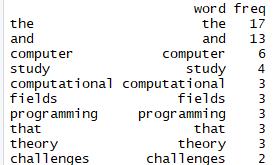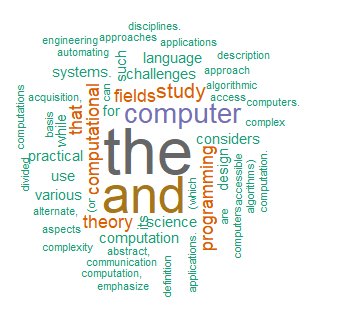Generating Word Cloud in R Programming
Last Updated :
29 Jul, 2021
Word Cloud is a data visualization technique used for representing text data in which the size of each word indicates its frequency or importance. Significant textual data points can be highlighted using a word cloud. Word clouds are widely used for analyzing data from social network websites.
Why Word Cloud?
The reasons one should use word clouds to present the text data are:
- Word clouds add simplicity and clarity. The most used keywords stand out better in a word cloud
- Word clouds are a potent communication tool. They are easy to understand, to be shared, and are impactful.
- Word clouds are visually engaging than a table data.
Implementation in R
Here are steps to create a word cloud in R Programming.
Step 1: Create a Text File
Copy and paste the text in a plain text file (e.g:file.txt) and save the file.
Step 2: Install and Load the Required Packages
Python3
install.packages("tm")
install.packages("SnowballC")
install.packages("wordcloud")
install.packages("RColorBrewer")
library("tm")
library("SnowballC")
library("wordcloud")
library("RColorBrewer")
|
Step 3: Text Mining
- Load the Text:
The text is loaded using Corpus() function from text mining(tm) package. Corpus is a list of a document.
- Start by importing text file created in step 1:
To import the file saved locally in your computer, type the following R code. You will be asked to choose the text file interactively.
Python3
text = readLines(file.choose())
|
- Load the data as a corpus:
Python3
docs = Corpus(VectorSource(text))
|
- Text transformation:
Transformation is performed using tm_map() function to replace, for example, special characters from the text like “@”, “#”, “/”.
Python3
toSpace = content_transformer
(function (x, pattern)
gsub(pattern, " ", x))
docs1 = tm_map(docs, toSpace, "/")
docs1 = tm_map(docs, toSpace, "@")
docs1 = tm_map(docs, toSpace, "#")
|
- Cleaning the Text:
The tm_map() function is used to remove unnecessary white space, to convert the text to lower case, to remove common stopwords. Numbers can be removed using removeNumbers.
Python3
docs1 = tm_map(docs1,
content_transformer(tolower))
docs1 = tm_map(docs1, removeNumbers)
docs1 = tm_map(docs1, stripWhitespace)
|
Step 4: Build a term-document Matrix
Document matrix is a table containing the frequency of the words. Column names are words and row names are documents. The function TermDocumentMatrix() from text mining package can be used as follows.
Python3
dtm = TermDocumentMatrix(docs)
m = as.matrix(dtm)
v = sort(rowSums(m), decreasing = TRUE)
d = data.frame(word = names(v), freq = v)
head(d, 10)
|
Step 5: Generate the Word Cloud
The importance of words can be illustrated as a word cloud as follows.
Python3
wordcloud(words = d$word,
freq = d$freq,
min.freq = 1,
max.words = 200,
random.order = FALSE,
rot.per = 0.35,
colors = brewer.pal(8, "Dark2"))
|
The complete code for the word cloud in R is given below.
Python3
install.packages("tm")
install.packages("SnowballC")
install.packages("wordcloud")
install.packages("RColorBrewer")
library("tm")
library("SnowballC")
library("wordcloud")
library("RColorBrewer")
text = readLines(file.choose())
docs = Corpus(VectorSource(text))
toSpace = content_transformer(
function (x, pattern)
gsub(pattern, " ", x))
docs1 = tm_map(docs, toSpace, "/")
docs1 = tm_map(docs, toSpace, "@")
docs1 = tm_map(docs, toSpace, "#")
strwrap(docs1)
docs1 = tm_map(docs1, content_transformer(tolower))
docs1 = tm_map(docs1, removeNumbers)
docs1 = tm_map(docs1, stripWhitespace)
dtm = TermDocumentMatrix(docs)
m = as.matrix(dtm)
v = sort(rowSums(m),
decreasing = TRUE)
d = data.frame(word = names(v),
freq = v)
head(d, 10)
wordcloud(words = d$word,
freq = d$freq,
min.freq = 1,
max.words = 200,
random.order = FALSE,
rot.per = 0.35,
colors = brewer.pal(8, "Dark2"))
|
Output:


Advantages of Word Clouds
- Analyzing customer and employee feedback.
- Identifying new SEO keywords to target.
- Word clouds are killer visualisation tools. They present text data in a simple and clear format
- Word clouds are great communication tools. They are incredibly handy for anyone wishing to communicate a basic insight
Drawbacks of Word Clouds
- Word Clouds are not perfect for every situation.
- Data should be optimized for context.
- Word clouds typically fail to give the actionable insights that needs to improve and grow the business.
Like Article
Suggest improvement
Share your thoughts in the comments
Please Login to comment...